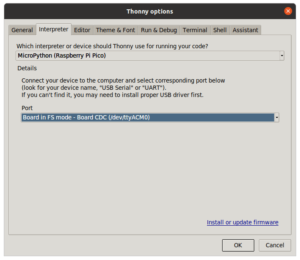

- #Install thonny on raspberry pi how to
- #Install thonny on raspberry pi install
- #Install thonny on raspberry pi software
- #Install thonny on raspberry pi code

In addition to Thonny and BlueJ, the Scratch program is also an excellent option for users with little experience in programming projects.
#Install thonny on raspberry pi software
For instance, we can leverage Thonny software to develop in Python, which is a beginner-friendly programming language that offers an extensive range of libraries and frameworks for development. Before we start, we will need to open the Thonny IDE.
#Install thonny on raspberry pi how to
The following steps will show you how to open Thonny on your Raspberry Pi and how to write a tiny bit of Python.
#Install thonny on raspberry pi code
An IDE makes writing code a cleaner, faster and better experience. To develop projects on a Raspberry Pi, we can utilize a vast array of open-source software depending on the nature of our project. The desktop versions of Raspberry Pi OS come pre-installed with a Python IDE called Thonny. Applications to program on the mini board Its structures are tailored to the needs of novice programmers, making it an ideal choice for use on a Raspberry Pi. To develop projects on a Raspberry Pi, we can utilize a vast array of open-source software depending on the nature of our project.

You don’t need to configure anything related to Python.

Click on the top left icon representing a raspberry > Programming > Thonny Python IDE. Once this is done, starting Thonny IDE is very simple.
#Install thonny on raspberry pi install
Personally, I think everyone who writes in Python should take a look at Thonny. Lets connect these to a Raspberry Pi Pico, using the Positional Servo as well use that first in the following examples. First, obviously, you need to install Raspberry Pi OS on a microSD card, for your Raspberry Pi board. There are a lot of features (for which take a look at the MagPi article linked above) including step-through and variable debugging in Thonny that we didn’t touch the surface of, so I can only give you a surface-level opinion. Your Pico W will connect to your Wi-Fi access point, and then to the. Click on Run (the green arrow in the toolbar) to start the code. This makes it feel much more integrated than IDLE, and much tidier as a result. Save the code as mqtt-pub.py to your Raspberry Pi Pico W. Once the board is in bootloader mode, it should appear as a USB drive on your computer. Make sure the board is in bootloader mode by pressing and holding the 'BOOTSEL' button while connecting the USB cable. Instead of the pop-up execution window you get with IDLE, Thonny runs the code in a Shell tab below the coding window. Here are the steps to follow: Connect the Raspberry Pi Pico W board to your computer using a USB cable. To use Thonny with the Raspberry Pi Pico. Ben made a risky move and got us to use Thonny rather than IDLE, the de-facto editor for Python. Thonny runs on a variety of systems including Windows, MacOS, and Linux. The workshop, which taught us how to use GPIO Zero’s remote control features, along with other examples using the library, was excellent. I recently attended a Raspberry Jam at Pi Towers and was lucky enough to take part in a workshop run by Ben Nuttall. The MagPi has done a great tutorial and walkthrough of the features of the editor here. Called Thonny, it has just been added into the Raspbian image. There’s a new IDE (Integrated Development Environment) on the block.


 0 kommentar(er)
0 kommentar(er)
